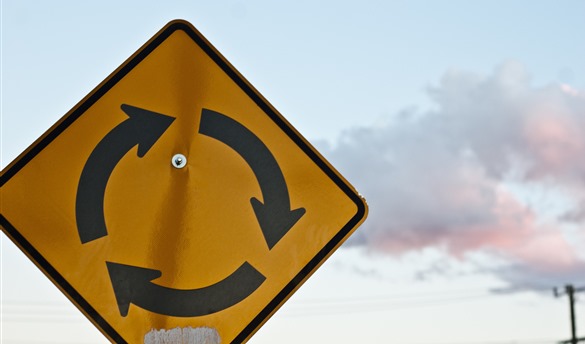
Australia Roundabout Sign – Photo Courtesy of John Jack Rice
We recently posted an article discussing the benefits of roundabouts. Roundabouts are an inexpensive and effective way to increase traffic flow, calm traffic, and improve safety while reducing the environmental impact of motor vehicles.
We wrote:
“When there is enough space to construct them, roundabouts are an extremely efficient way to keep traffic moving while also improving safety for pedestrians and bicyclists when designed properly.
A Dutch study of 181 intersections that were converted to roundabouts found a reduction of 73% in pedestrian crashes. The National Cooperative Highway Research Program (NCHRP Report 572) found a 67% overall reduction in collisions following the implementation of roundabouts at 26 multi-lane intersections.”
However, roundabouts are not always effective at improving safety. As pointed out by Bicycle Perth, they can make the situation more dangerous and uncomfortable for pedestrians and bicyclists when designed poorly, as appears to be the case in Australia.
“[In Western Australia] our roundabouts create conditions that are worse for pedestrians and cyclists.
At a standard intersection, pedestrians in Western Australia have priority (right-of-way) over turning vehicles. If that same intersection is changed to a roundabout, pedestrians lose that right. All turning vehicles then have priority.”
…
“The only way for pedestrians to regain this loss of priority is for a crosswalk to be installed. There are hundreds of roundabouts throughout Western Australia. The City of Fremantle is the only local area, that I am aware of, that has provided them.”
Like most types of traffic infrastructure, there is good design and bad design. A good proportion of bike lanes in North America are poorly designed and thus aren’t nearly as comfortable as they could be. We were careful to include a stipulation in our original article to indicate that Dutch-style roundabouts are the “ideal” design.
Bicycle Perth discusses how Australia got it wrong with roundabouts:
“The trouble is, the Australia roundabout is usually built in a way that allows for the fast flow of motor vehicles. Pedestrians have no priority and cyclists are pushed into the motor vehicle lane or have to retreat to the footpath with the pedestrians.”
Indeed the roundabouts here in Canada that we originally wrote about leave much to be desired – since there are no provisions for bicyclists and pedestrians. But given the rural highway setting, these provisions wouldn’t do much in the absence of bike paths or sidewalks.
A commenter on the Bicycle Perth article sums up the Australia vs. Netherlands comparison nicely:
“I agree with the gist of this article – UK- or Australian-style roundabouts are no good for riding bikes. They’re horrible, in fact – my partner refuses to ride across them!
Dutch-style roundabouts, however, are a joy to use. Having visited the Netherlands this year, we’d ridden across a roundabout without even realising it! They’re excellent for people walking, people riding bikes – and for people driving cars.”
James D. Schwartz is a Transportation Pragmatist and the Editor of The Urban Country. You can contact James at james.schwartz@theurbancountry.com or follow him on Twitter.
Related Articles:
- Roundabout Junctions: Efficient, Inexpensive (Jan 2013)
- Snow Traffic-Calming Measures (March 2011)
- No Cars. No Traffic Signals. No Deaths. (June 2011)
- Rural Bike Infrastructure in the Netherlands (March 2012)
- My Ideal World (Sept 2012)



Whew, I thought I was being a crank in my comment on the last post.
Whew, I thought I was being a crank in my comment on the last post.